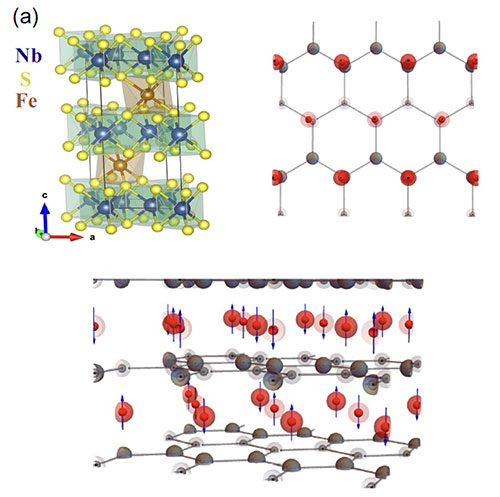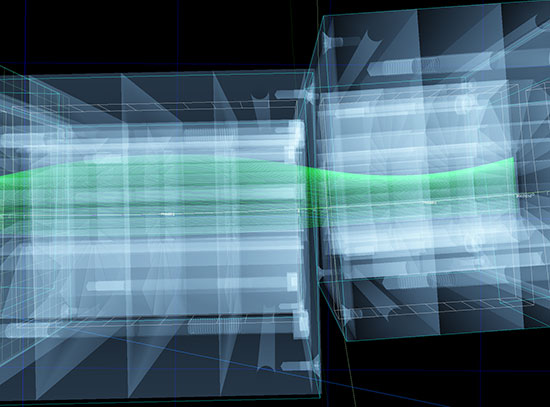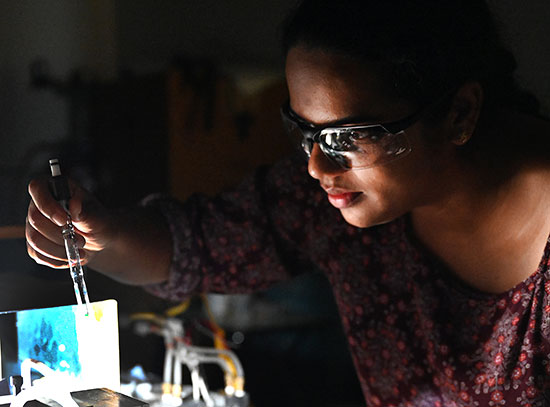Discovery of Electric Charge Order in a Potential Quantum Material
March 11, 2024
 enlarge
enlarge
(a) The crystal structure of Fe0.35NbS2. (b) and (c) Charge order patterns in the over-intercalated (x = 0.35) sample. Credit: Phys Rev Lett 131, 186701 (2023)
The Science
A novel charge order phase was discovered in iron niobium disulfide, an intercalated transition metal dichalcogenide (TMD).
The Impact
This is the first instance of a charge order phase in the intercalated TMDs, suggesting that FexNbS2 is a strongly correlated electron system; it may have future applications in quantum computing, energy-efficient storage, and other frontier technologies.
Summary
The transition metal dichalcogenides (TMDs) are a family of materials that exhibit complex electronic and magnetic properties, which are often linked to phonons (vibrations) in the atomic lattice. These properties include ordered electronic phases, such as the charge density wave and superconducting phases. Because of their many fascinating behaviors, TMDs have the potential for use in many applications, such as opto-electronics and quantum computing. But in the "intercalated" TMDs, which are characterized by metal atoms that are wedged in between the layers of the atomic structure, no charge ordering had been observed – until now.
In this study, researchers investigated samples of the intercalated TMD iron niobium sulfide (FexNbS2), both in over-intercalated and under-intercalated forms. They used synchrotron x-ray scattering techniques at multiple facilities, including the Integrated In Situ and Resonant Hard X-ray Studies (ISR) beamline at the National Synchrotron Light Source II, a U.S. Department of Energy Office of Science User Facility. Their results indicate the presence of a three-dimensional charge order phase that is antiferromagnetic, taking a zigzag pattern when over-intercalated and a stripe pattern when under-intercalated. The temperature dependence of the charge order suggests that it comes from a magneto-elastic coupling effect. This work opens up a new pathway for phenomena related to spin and charge order in TMDs with similar geometries.
Download the research summary slide (PDF)
Contact
Shan Wu
University of California Berkeley
shanwu@berkeley.edu
Robert J. Birgeneau
University of California Berkeley
robertjb@berkeley.edu
Publications
S. Wu, R. Basak, W. Li, J. Kim, P. Ryan, D. Lu, M. Hashimoto, C. Nelson, R. Acevedo-Esteves, S.C. Haley, J.G. Analytis, Y. He, A. Frano, R.J. Birgeneau. Discovery of Charge Order in the Transition Metal Dichalcogenide FexNbS2. Phys Rev Lett 131, 186701 (2023). doi: 10.1103/PhysRevLett.131.186701
Funding
This work is funded by the U.S. Department of Energy, Office of Science, Office of Basic Energy Sciences, Materials Sciences and Engineering Division under Contract No. DE-AC02-05-CH11231 within the Quantum Materials Program (KC2202). This material is based upon work supported by the National Science Foundation under Grant No. DMR-2145080. A. F. was supported by the Research Corporation for Science Advancement via the Cottrell Scholar Award (27551) and the CIFAR Azrieli Global Scholars program. The photoemission work is partially supported by National Science Foundation under Grant No. DMR-2239171. This research used resources of the Advanced Photon Source, a U.S. Department of Energy (DOE) Office of Science user facility operated for the DOE Office of Science by Argonne National Laboratory under Contract No. DE-AC02- 06CH11357. Use of the Stanford Synchrotron Radiation Lightsource, SLAC National Accelerator Laboratory, is supported by the U.S. Department of Energy, Office of Science, Office of Basic Energy Sciences under Contract No. DE-AC02-76SF00515. This research used beamline 4-ID of the National Synchrotron Light Source II, a U.S. Department of Energy (DOE) Office of Science User Facility operated for the DOE Office of Science by Brookhaven National Laboratory under Contract No. DE-SC0012704.
2024-21786 | INT/EXT | Newsroom








